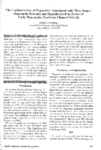- DSpace Home
- →
- Channel Islands
- →
- National Park Service
- →
- California Islands Symposia Documents
- →
- 3rd California Islands Symposium
JavaScript is disabled for your browser. Some features of this site may not work without it.
| dc.contributor.author | Cushing, John E. | en |
| dc.date.accessioned | 2011-01-13T19:18:38Z | en |
| dc.date.available | 2011-01-13T19:18:38Z | en |
| dc.date.issued | 1993 | en |
| dc.identifier.citation | Cushing, John E. "The Carbonization of Vegetation Associated with "Fire Areas," Mammoth Remains and Hypothesized Activities of Early Man on the Northern Channel Islands." In: 3rd California Islands Symposium. 1987. 551-556. | en |
| dc.identifier.uri | http://hdl.handle.net/10139/3023 | en |
| dc.description.abstract | The carbonized vegetation associated with Pleistocene "fire areas" and mammoth and bird fossils on the Northern Channel Islands has been attributed to wildfires and to the cooking of mammoths by humans. This paper elaborates on the hypothesis (Cushing et al. 1986) that such carbonization occurred in groundwater. Fire and water carbonizations are compared. A search for methods which distinguish directly between residues of these two processes is reported as unsuccessful, leading to the conclusion that, as with interpreting radio-carbon dated material, research on i n situ circumstantial evidence is necessary in order to interpret carbonized residues as charcoal. | en |
| dc.language.iso | en_US | en |
| dc.publisher | National Park Service | en |
| dc.subject | California Islands | en |
| dc.subject | Channel Islands | en |
| dc.subject | Santa Cruz Island | en |
| dc.subject | San Miguel Island | en |
| dc.subject | Santa Rosa Island | en |
| dc.subject | fire | en |
| dc.subject | carbonization | en |
| dc.subject | groundwater | en |
| dc.title | The Carbonization of Vegetation Associated with "Fire Areas," Mammoth Remains and Hypothesized Activities of Early Man on the Northern Channel Islands | en |
| dc.type | Article | en |

